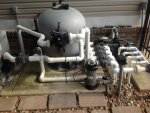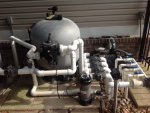Thanks for your replies. Joyfulnoise, I send you a message; please read it if you have chance.
Now I have more questions than I can type...I'm on a well so it's not so easy to change water. I can make up about 350 gal per day then I have to let a iron filter regen.
I have not used chlorine, but just shocked for the second time this year.
Why can't I live out bromine this year, run the bromine levels down at the end of year - then when I open the pool next season just switch to chlorine - I figure after 11 months of winter in Cleveland, any bromine is long gone - right?
- - - Updated - - -
Btw - I' m sick and tired of cleaning the pool every time I want to use it so I'm planning on buying a dolphin triton.
Any comments?
I measure Summer's by how many times I clean vs. how many times I swim.
So far it's seven to two. Not good.
Jeff,
PM'd you back.
I have to say, you're in a pickle with this pool. Honestly speaking, you'd be better off draining the pool (if you could) and start over with chlorine. Bromine does not go away with time except through fresh water exchange. It does not evaporate and it does not leave the pool by any chemical means. Once you add chlorine to a bromine pool, the chlorine oxidizes the bromide and creates bromine. So all of the chlorine gets used up. Unfortunately there's no way to distinguish between chlorine and bromine with the test available to residential pool owners. So even if you add chlorine to your pool, the test can not tell you how much of the color change you see is due to bromine and how much is due to chlorine; it's just a total sanitizer level.
You say you're on well water. Is getting fill water by truck even a possibility? You could drain your pool down to the point where you leave one foot of water in the shallow end and then refill with fresh water (assuming your liner is in good enough shape to handle the drain and your water table is low). You repeat that process until you get enough dilution to get rid of most of the bromine.
The only other non-draining possibility (and it's kind of remote in your area of the country) is reverse-osmosis (RO) filtration. RO removes everything from the water and typically has a waste fraction of about 85% or so. That means you'd need to make up about 15% of your water volume from your well. RO is typically the most expensive option available but it gets rid of everything in the water (bromide, calcium, DMH, dissolved salts, etc, etc).
You can certainly limp along this year by trying to shock your pool with chlorine to get the bromine sanitizer level to hold, but it's going to be a constant fight. That's what's basically happening now - you fight to get your pool clear of algae by hitting it with bromine (and vacuuming, brushing, etc) and then the water has some sanitizer in it and clears. The sanitizer levels drop to zero quickly, you go off to do other things and, next thing you know, the algae is back. It's always a constant fight with bromine in pools and this is why so few pools choose to use it and why chlorine is a much better choice.
Let us know what kind of options you have for water exchange.
Oh, and Welcome

to TFP....
Matt


 to TFP....
to TFP....
